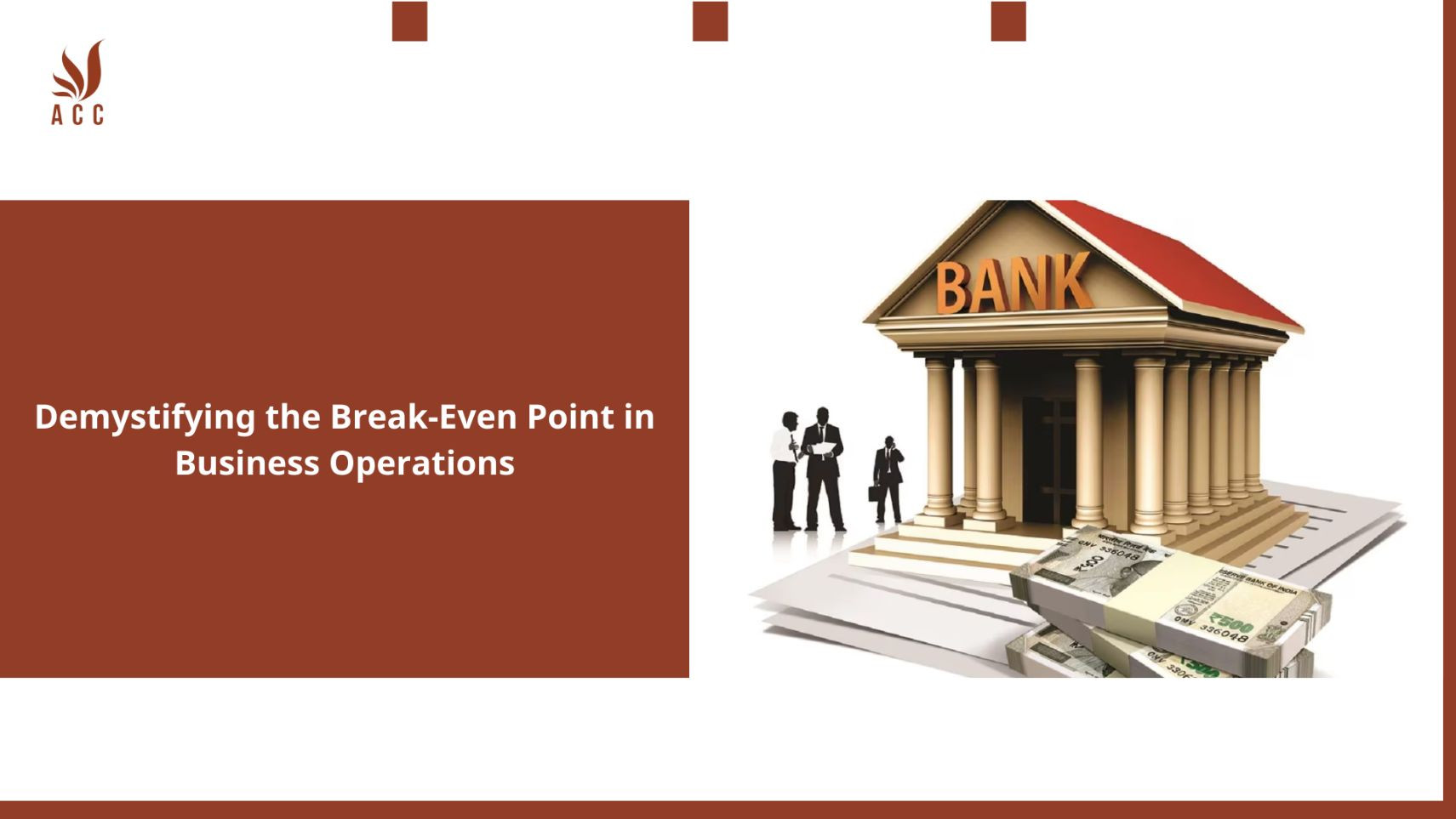
1. Demystifying the Break-Even Point in Business Operations
Starting a business, launching a new product, or expanding your venture is often driven by a vision and ambition. However, taking the plunge without assessing your risks can be a risky endeavor. In this article, we'll explore the concept of break-even analysis – a valuable tool that can guide your business decisions, helping you determine the point at which your venture becomes profitable. We'll break down the fundamentals, its importance, and how you can use it effectively to outshine your competition.
2. Understanding Break-Even Analysis
A break-even analysis is a financial calculation that compares the costs of your business, service, or product against the selling price per unit. This analysis is designed to pinpoint the precise moment when your sales revenue equals your total costs, signifying neither profit nor loss.
Key Takeaways:
- Break-even analysis is about achieving a dollar-for-dollar balance in your investment, neither gaining nor losing.
- Lower fixed costs generally result in a lower break-even point.
- It's crucial to differentiate between fixed and variable costs when conducting a break-even analysis.
- Lowering your break-even point can be accomplished by cost reduction and price adjustment.
3. Decoding the Mechanics of Break-Even Analysis
A break-even analysis is a vital internal tool for businesses, providing insights into financial projections, investment needs, and potential risks. Financial institutions may request it when applying for a loan, emphasizing its significance.
The analysis factors in two types of costs: fixed and variable. Fixed costs remain constant, regardless of your sales volume, including expenses like rent, equipment, salaries, and insurance. Variable costs fluctuate with your sales, including labor costs, raw materials, and commissions.
The contribution margin is a pivotal metric in break-even analysis, calculated by subtracting the total variable cost from the selling price. This margin contributes to covering fixed costs.
Unit Contribution Margin = Sales Price - Variable Costs
In general, lower fixed costs translate to a lower break-even point, provided that variable costs do not exceed sales revenue.
4. Why Your Business Needs Break-Even Analysis
Break-even analysis holds immense value for startups, new product lines, and established businesses looking to expand or innovate. It can help you assess the capital needed for your venture, evaluate risks, and guide decision-making processes, such as hiring new employees or entering new markets.
Determining the Break-Even Time Period
An acceptable break-even period typically ranges from six to 18 months. If your analysis suggests a break-even point beyond this timeline, it serves as a red flag, indicating the need for cost reduction or price adjustments to mitigate risks.
When to Use Break-Even Analysis
Break-even analysis is a versatile tool to evaluate any scenario involving additional costs, making it indispensable for:
-
Expanding Your Business: Assess the time it will take for your investment to turn profitable, helping you make informed decisions, such as entering new markets.
-
Lowering Pricing: When competing in a price-sensitive market, a break-even analysis helps you understand how many additional units you need to sell to compensate for lower prices.
-
Narrowing Down Business Scenarios: Simplify complex decision-making by using break-even analysis to compare different scenarios, making it easier to determine the best path forward.
5. Calculating the Break-Even Point
While modern software can automate break-even calculations, it's essential to understand the formula behind it:
Break-even quantity = Fixed costs / (Sales price per unit - Variable cost per unit)
For example, let's say Beth plans to open a gourmet cupcake store. Her fixed costs for the first year are $10,000, variable costs are $0.50 per unit, and she intends to sell each cupcake for $6. Applying the formula:
$10,000 / ($6 - $0.50) = 1,819 cupcakes required to break even in one year.
6. The Limitations of Break-Even Analysis
It's crucial to remember that break-even analysis doesn't account for market demand. Knowing the quantity you need to sell to break even doesn't guarantee when or if you can sell those units. Business passion must be balanced with practicality.
Additionally, reaching the break-even point may demand considerable effort and time. You must weigh the investment in terms of sales, effort, and time it will require. Adjusting prices to boost sales may help, but beware of increasing variable costs and raising your break-even point in the process.
7. Strategies to Lower Your Break-Even Point
To reduce your break-even point effectively, you have two primary options: lowering costs and raising prices. However, these actions should be well-considered, as hasty decisions can impact profitability and brand reputation. Furthermore, outsourcing and optimizing quality and delivery can help cut costs when demand increases.
In conclusion, break-even analysis is a powerful tool to guide your business decisions, ensuring you navigate the path to profitability with clarity and confidence. By understanding the principles of break-even analysis and utilizing them effectively, you can stay ahead of the competition and make informed choices that lead to success. So, before you embark on your business journey, make sure to calculate your break-even point and plot your course to prosperity.
8. Why should professionals use ACC Law Firm's capital Service?
-
Expertise in Legal Matters: ACC Law Firm specializes in legal services, providing professionals with access to experienced attorneys who can offer valuable legal guidance. Whether it's contract negotiations, intellectual property issues, employment matters, or any other legal concern, their expertise can be invaluable.
-
Tailored Legal Solutions: ACC Law Firm understands that every professional's needs are unique. They can customize their legal services to address the specific challenges and opportunities faced by professionals in different fields.
-
Risk Mitigation: Legal issues can pose significant risks to professionals and their businesses. ACC Law Firm can help identify and mitigate these risks, reducing the potential for costly legal disputes or compliance issues.
-
Resource Optimization: Professionals can save time and resources by outsourcing their legal needs to ACC Law Firm. This allows them to focus on their core competencies and business objectives, while leaving legal matters in the hands of professionals.
-
Access to a Network: ACC Law Firm may have a network of legal experts and professionals in various fields, which can be beneficial for clients seeking connections and advice beyond just legal services.
Q&A
Question 1: What is the break-even point in a business, and why is it significant?
Answer 1: The break-even point is the level of sales or revenue at which a business neither makes a profit nor incurs a loss. It is a critical milestone for businesses as it helps them determine when they will cover all their costs and start generating profit.
Question 2: How is the break-even point calculated, and what factors are involved in the calculation?
Answer 2: The break-even point is calculated by dividing the total fixed costs by the contribution margin, which is the selling price per unit minus the variable cost per unit. The formula is:
Break-Even Point (in units) = Total Fixed Costs / Contribution Margin per Unit
Question 3: Why is understanding the break-even point important for business owners and managers?
Answer 3: Understanding the break-even point is crucial for business owners and managers because it helps them:
- Assess the financial feasibility of their business.
- Set sales targets and pricing strategies.
- Make informed decisions about cost control and expansion plans.
- Determine the level of risk associated with their business operations.
Question 4: Can the break-even point change over time, and if so, what factors might influence it?
Answer 4: Yes, the break-even point can change over time due to various factors, including changes in fixed costs, variable costs, selling prices, and sales volume. Business growth, cost reduction strategies, and shifts in market conditions can all impact the break-even point. It's essential for businesses to regularly reassess their break-even analysis to adapt to these changes.
Nội dung bài viết:






Bình luận